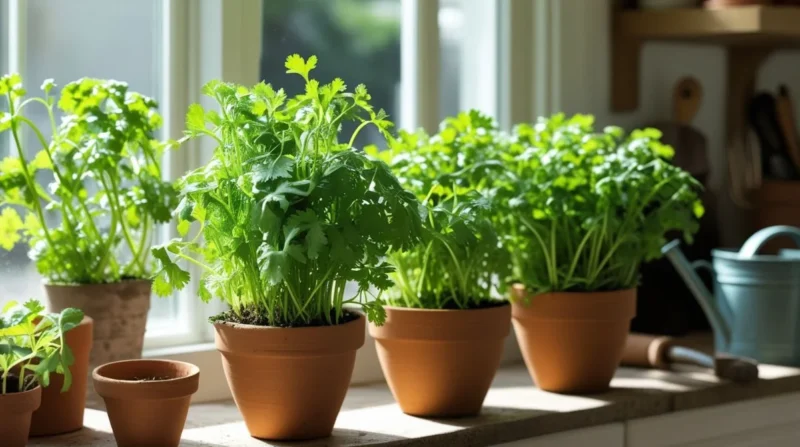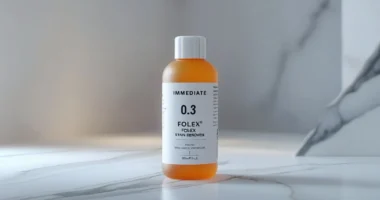Table of Contents
Have you ever added kinza herb to your dishes and loved that burst of fresh flavor? Instead of buying it often from the store, you can grow your own at home, no garden required! It’s simple, affordable, and gives you access to fresh leaves any time you want.
What Exactly is Kinza Herb?
Kinza, also called cilantro or coriander in different regions, is a fast-growing herb known for its fresh green leaves and fragrant seeds. It’s commonly used in chutneys, curries, salsas, and salads. You can use the whole plant in cooking, from its tender leaves to the flavorful seeds, as it’s part of the parsley family.
Why You Should Grow Kinza at Home?
Growing kinza at home offers several everyday benefits:
- You get freshly picked leaves whenever you need them.
- It reduces your kitchen costs.
- You avoid chemicals used in commercial farming.
- It grows quickly and takes up little space.
- You control the growing environment for better flavor and quality.
What You’ll Need to Start?
Here’s a list of basic items to begin growing kinza herb at home:
- Kinza seeds (easily found online or at garden shops).
- A medium-sized pot or planter (at least 6 inches deep).
- Soft, nutrient-rich soil (ideally loamy with compost).
- Watering spray bottle or small watering can.
- A spot with at least 4–6 hours of sunlight (like a window or balcony).
How to Grow Kinza Herb at Home?
1. Choose the Right Pot and Soil
Pick a container with holes at the bottom so excess water can escape. Fill it with loose, fertile soil that drains well. If your soil feels heavy or clay-like, mix in compost or sand to make it lighter and more breathable.
2. Prepare the Seeds for Planting
Kinza seeds are small and round, often stuck in pairs. To boost their sprouting chances:
- Lightly crush them to split the seeds into single units.
- Soak them in water overnight (12–24 hours) to soften the outer shell.
3. Plant the Seeds Properly
After soaking:
- Sprinkle the seeds evenly across the soil surface.
- Gently press them down about 1/4 inch deep.
- Cover with a thin layer of soil.
- Lightly mist with water to keep the soil moist.
4. Set Up in a Sunny Spot
Kinza grows best in a place where it gets direct sunlight for 4 to 6 hours daily. A bright window, a sunny kitchen corner, or a balcony is perfect. If the weather is too hot, try placing it where it gets morning sun and afternoon shade.
5. Water Consistently but Gently
Keep the soil moist, especially in the first two weeks. Use a spray bottle to mist it daily or whenever the top layer feels dry. Avoid overwatering, as it can cause the roots to rot.
6. Wait for Sprouts to Appear
The seeds typically begin to sprout in about 7 to 10 days. ou’ll notice tiny green shoots poking through the soil. Don’t disturb them during this phase, just keep the soil damp and give them light.
7. Thin Out the Seedlings
Once the plants reach about 2–3 inches tall:
- Remove weaker or overcrowded shoots.
- Leave 2–3 inches of space between healthy ones.
8. Take Care of Your Growing Kinza
- Light: Ensure the plants get good light daily. If indoors, rotate the pot occasionally.
- Feeding: Add a light dose of compost or organic liquid fertilizer every two weeks.
- Pests: Check the leaves for bugs like aphids. Use neem spray or a gentle soap solution if needed.
9. How and When to Harvest Kinza
Around 3 to 4 weeks after planting, your kinza is ready to harvest:
- Cut the outer leaves first using clean scissors.
- Leave the central leaves untouched so the plant keeps growing.
- Harvest regularly, every few days for the best flavor.
If you let the plant continue growing, it will eventually flower and produce seeds, which you can collect for future planting.
Expert Tips for Best Results
- Plant fresh seeds every few weeks to ensure a steady harvest.
- Avoid hot afternoons, especially during summer, kinza bolts quickly in high heat.
- Rotate indoor pots so each side gets equal sunlight and grows evenly.
- Store extra leaves in a zip bag in the fridge for up to 5 days.
Common Growing Problems and Easy Fixes
Even with the best care, you may face small issues. Here’s how to solve them quickly:
Seeds Aren’t Sprouting?
- Make sure you soaked and split the seeds.
- Don’t bury them too deep, just 1/4 inch is enough.
- Plant fresh seeds every few weeks to ensure a steady harvest.
Leaves Turning Yellow?
- Check for overwatering, let the topsoil dry before watering again.
- Improve drainage if water is collecting at the base.
- Move to a brighter spot if there’s not enough sunlight.
Plants Look Weak or Too Tall?
- This usually means they’re stretching for light.
- Move them closer to a sunny window or increase light exposure.
- Rotate the container often for even growth.
Flowering Too Early (Bolting)?
- Happens due to heat or plant stress.
- Grow kinza during cooler months (spring/fall).
- Regular harvesting helps delay flowering.
- Offer shade during hot afternoons.
Pests on Leaves?
- Look for tiny insects or white patches.
- Spray neem oil or diluted dish soap solution.
- Keep plants clean and don’t overcrowd them.
Keep Nurturing and Enjoy the Process
Now that your kinza is thriving, keep an eye on its progress and enjoy the fresh flavor it brings to your meals. Growing herbs like this can become a relaxing and rewarding part of your daily routine.









